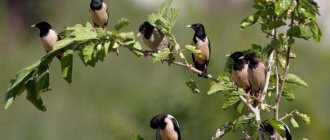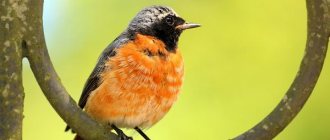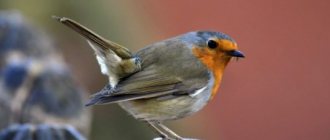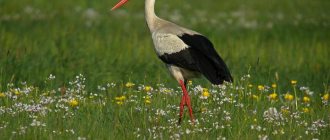The robin (robin) is the most numerous bird of the thrush family. This big-eyed, curious creature with a reddish chest has probably come across you in forests, parks and gardens, where it has settled since the beginning of April. And it’s impossible to forget her bell-like trills, even after hearing them only once.
The robin is popularly considered a close relative of the nightingale, thanks to its amazing song, similar to a silver bell. The early morning begins with these ringing, iridescent chants, and at sunset they end a long, busy day. That's why they called the wonderful bird the Robin.
But sometimes her gentle melodies can be heard in the transparent summer twilight, then they seem especially magical.
Robin - a migratory bird
In March - April, as soon as thawed patches appear, the song of the robin begins to ring along with the spring streams. This means that the male has flown in to find a nesting place: in dense bushes, under tree roots, and sometimes in hollows. The caring head of the family protects his territory, notifying by singing that the area is occupied, and if necessary, he uses force. Later, the female flies to the conquered place and begins building the nest.
How a nest is built
The robin is a bird that is not afraid of the proximity of human habitations. Therefore, in May, its neat nests, similar to small wicker baskets, with five or six pale pink, brown-speckled eggs can be found in the dense raspberry bushes in your own garden. The main thing is not to touch them, so as not to frighten off the diligent parents who take turns incubating their future offspring.
The appearance of offspring
After two weeks, tiny naked chicks will appear in the clutch, which after only 14 days, having not even learned to fly, will leave the nest. The kids will jump in the grass, freezing and ruffling up in danger, about which they will be warned by their parents, who vigilantly guard their brood and continue to feed it.
But the robin is a bird that lays two clutches per season, and therefore, as soon as the breasts of the grown chicks become bright, they will be barred from entering the parental territory. For a male robin, an orange breast is a sign of a rival.
It’s not for nothing that people love to keep this amazing songbird in the house. Already on the second day after being caught, the robin begins to sing. This is a rather unpretentious bird. But the main traits of her character include quarrelsomeness and pugnacity. Therefore, it is not worth keeping a robin in a common cage with other birds. But alone, like most singers, he will delight you with his wondrous trills all year round.
Don't forget that the robin is a bird that loves to swim. Therefore, change her water at least twice a day. Feed your pets insects and special mixtures of seeds and grains. Pet birds should also be pampered with berries (preferably elderberries).
It should be said that the robin gets used to the person feeding it very quickly and willingly takes food from the hands.
The robin bird, the photo of which you see in the article, will certainly become your pet, which even in the middle of winter brings a breath of spring and warmth into the house.
Their closest relatives are, while scientists currently know only two varieties of these birds: the Japanese robin and the common robin.
Features and habitat of the robin
Description of the robin bird
It’s worth starting with the fact that this bird has a rather modest size and is clearly inferior in size to ordinary ones. These birds reach 12 centimeters in length, and their wingspan varies from 19 to 22 centimeters.
The weight of these small representatives of the thrush family usually ranges from 16 to 24 grams. The beak, like the eyes, is a rich black color.
Males and females have identical plumage, but the color of males is much more pronounced. Looking at a photo of a robin bird
you can see that the plumage of most individuals of this species is brownish-brown with olive undertones.
The abdominal part of the birds is white, and the color of the front of the head and chest is usually bright red. The birds' feet are brown, and young chicks often have orange spots.
Common robins can be found throughout the vast territory of Europe, as well as in North-West Africa, western Siberia and the Caucasus. Japanese robins live respectively in Japan and in some regions and provinces of China.
Those birds that live in southern latitudes have a sedentary lifestyle, while those that live to the north are migratory. Robins living in the North-Eastern European regions migrate to the western part of Europe, Asia Minor or the northern territories of Africa during the cold season.
These birds return from wintering in early spring. First, the males arrive and rush to occupy the vacant nests, and then the females join them.
Most often, robins can be found among a wide variety of forests, bushes, as well as in parks and gardens. It is not at all afraid of humans, so it often explores urban spaces during the cold season.
At the end of the nineteenth century, they wanted to artificially introduce robins to New Zealand and Australia, but this experiment ended in failure.
Despite the fact that these relatives of nightingales are not at all afraid of people, buy a robin bird
today it is very difficult, since they take root very poorly in captivity.
According to European folklore, it was the robin who sang songs to Jesus as he died on the crucifixion, trying to ease his torment with her wonderful music.
An ancient British parable tells that this tiny one tried to help Christ remove the crown of thorns, so her chest has red spots as a symbol of Jesus' blood. The British believe that this is why robins in the vast Albion begin to perform their songs just before Christmas.
Character and lifestyle of the robin
Robin - a migratory bird
, which by its nature is a strict and consistent individualist. She prefers not only a solitary lifestyle, but also solo flights.
These birds have a very well developed possessive instinct, and they can attack their neighbors who dare to be on their territory. Birds are active mainly during daylight hours, however, they can also be seen on a moonlit night or in the most illuminated places in the rays of night sources.
Hear the robin
possible in the evening or at night. During the mating season, males sing, attracting females with their own vocal talents. Robins prefer to build nests directly on the ground or near its surface.
They especially love places such as holes, rotten stumps, crevices between tree roots, or even abandoned burrows left by various mammals.
To build the outer walls of the nest, the robin bird uses moss, as well as dry leaves and branches. The interior of the nest is usually covered with feathers, wool, hairs, straws and thin roots. The robin always builds a reliable protection from rain over its own home or inhabits a recess into which moisture does not penetrate.
Robin feeding
The robin's diet consists mainly of centipedes, worms and all kinds of mollusks. The search for food of these birds is concentrated mainly along the surface of the earth.
Robins are also not averse to eating all kinds of berries and seeds, which people often feed them in city parks and squares. Most of all, the robin loves berries such as blackberries, currants, elderberries and rowan.
Reproduction and lifespan of a robin
Reproduction in these birds occurs twice a year, and in one clutch the female brings from five to seven eggs, from which young offspring are born two weeks later.
The photo shows a robin's nest
“Newborn” chicks do not have feathers, but after about half a month they already begin to leave the nest. In the first days of life, the chicks are very voracious and destroy many larvae and caterpillars of harmful insects, thereby providing an invaluable service to orchards and groves.
Despite the rapid deforestation in which the robins lived, they managed to change their location and perfectly adapt to new conditions. Therefore, the fact of destruction of forests did not negatively affect the population of these birds.
Mortality among juveniles is quite high, since the chicks are very trusting and most of them do not live to be one year old. If a robin can survive its difficult first year of life, then it is highly likely that it will live up to twelve years.
The robin bird got its name due to the specific coloring. It seems that the bird was too interested in eating raspberries. As a result, part of the head around the beak and the breast were splashed with raspberry juice. These red-breasted birds are also called robins. The bird received this second name not only because it sings beautifully at dawn. Looking at the morning bird, it seems that it sang for so long, admiring the rising sun, that it turned into dawn colors.
The robin bird got its name for the specific coloring
The robin taxonomically belongs to the phylum Chordata, order Passeriformes, family Flycatchers, genus Robin.
The body parameters of this bird are as follows:
- The plumage is small, soft and loose. On the wings, the first flight feather is underdeveloped; it extends only half of its length beyond the covert brush.
- Body length for males ranges from 12.2 to 16 cm, for females - from 14 to 16 cm. On average, these birds grow to about 15 cm, if, of course, you count the tail.
- The wingspan of males ranges from 21 to 25 cm, females - from 22 to 25 cm, on average, the distance from the edge of one wing to the edge of the other in an extended state is about 23 cm.
- The length of an individual wing in males ranges from 6 to 7 cm; in females the wings are almost the same, but usually a few millimeters longer.
- The average length of the tail in males and females is about 7 cm. The beak of any adult specimen measures about 1.5 cm.
- The weight of these birds is measured in very small quantities. There is practically no difference in weight between males and females. The weight range ranges from 17 to 19 g.
The robin bird has a very light build
The robin bird has a very light build. Its small thin beak reveals it as a predator that hunts small arthropods, mainly insects. Its belonging to the flycatchers speaks for itself. This cute little bird is a terrible enemy of flies, mosquitoes, small butterflies, caterpillars and other bugs,
inhabiting our gardens in abundance. For this reason, the sweet singing of the robin bird so often accompanies a person leading an agricultural lifestyle.
The relatively long, uncurved tail of the robin indicates the need for short, maneuverable flight. This flight is typical for insectivorous birds, which are forced to obtain their food in the complex environment of trees and shrubs.
However, the most noticeable feature of these birds is their bright coloration of the chest and front of the head. This makes the bird stand out in an environment where shades of green, brown and gray are mixed. Why should she take such risks and stand out from the crowd?
Sexual behavior and reproduction
The coloring of any bird, and especially small ones, is directly related to sexual behavior. In this diverse and hostile world, birds must distinguish friend from foe. In mammals, this function is assigned to the sense of smell. In birds, vision is the main thing, which is why so much importance is attached to the color of feathers.
The red-breasted bird stands out against the background of representatives of other colors so that it is seen primarily by the chicks. There is such a concept - imprinting, which refers to the process of imprinting the image of a parent. The chicks look at the bird with the orange breast that feeds them, and remember that this is exactly what their future reproductive partners should look like.
Yes, the robin with its bright colors takes a lot of risks.
However, the trick here is that from above she looks like a creature that blends perfectly into the background. And for small birds, the danger comes from above - from birds of prey. There are also, of course, terrestrial mammals like cats or mustelids, which perfectly see a bright spot on the chest. In this case, the robin has to rely only on its reaction and speed of movement.
Chicks that have just flown out of the nest do not have a characteristic mark, but soon their breasts acquire an orange color, and it immediately becomes clear who is inside and who is strangers.
Population and species status
Photo: Robin bird
Flycatchers are the most numerous and members of the passerine family. Scientists estimate their number from 135 to 335 thousand individuals. The vast majority of populations live in Europe. To date, the population is not in danger. Despite the fact that birds have quite a lot of enemies in natural conditions and their nests are often destroyed and chicks die, their numbers remain stable.
Range and habitats
There is a significant difference in the description of the range and habitats, although these concepts also have some similarities.
The range is the area where a given species lives. This does not mean that the territory outlined on the map is completely developed by individuals of this species. As a rule, all but a very small habitat has the appearance of cheese with holes. Indeed, within this territory there may be places where individuals of a given species find everything they need to implement their hereditary life support programs. However, in these same territories there are usually areas where this species is not able to live and reproduce successfully.
The robin prefers to live in deciduous or mixed forests with a complex structure.
Such forests should contain a wide variety of trees with a predominance of deciduous species. However, plant communities with a high level of mosaic and multi-layeredness are most suitable for these birds. They need forest windows and edges, where there is a lot of undergrowth and bushes. These birds feel good in a cleared forest with developed and lower tiers in the form of shrubs, dense undergrowth of trees, as well as a variety of grasses.
It is these preferences that allow the robin to live in territories transformed by humans. After all, gardens and fields surrounded by forest belts turned out to be an ideal environment for the orange-breasted bird. True, in this case there was a change of enemies. The robin's nests were no longer destroyed by weasels, stoats, foxes and wolves, but began to be destroyed by cats, dogs and, willingly or unwillingly, by humans.
This bird found such living conditions throughout almost all of Europe from Scandinavia to the Caucasus and the Mediterranean coast. In addition, the robin also lives in Africa, but only in the north of the continent, in the Mediterranean countries.
In Russia, the robin's range covers the entire European part of the country, crosses the Urals and, with a tapering tongue, reaches the Ob and Tom rivers in Western Siberia.
This bird is migratory.
Of all insectivorous birds, it is usually the last to fly away - at the end of September or even in October. In warm regions, for example, in Africa and Southern Europe, it does not fly anywhere, since these territories provide it with food all year round.
How the robin sings
The typical call is a clear "tick", repeated and spoken in short series of "tick-tick-tick..." by young and adult birds. The robin also makes a short, quiet or shrill and plaintive call of "siii" when alarmed or in danger.
The robin's song is a series of sound phrases, soft, clear sounds and sharp short trills.
The robin sings mainly to attract a female and to mark territory early in the morning while sitting on a pole. Sometimes he sings at night if he is near a street lamp. The robin sings all year round, except in late summer when it molts. In autumn the singing is softer, even a little melancholy.
Video recording of the robin's voice is at the bottom of the article.
Nest and clutch as a distinctive feature
Robins build their nest from leaves and blades of grass in depressions on the ground. This nest location is one of the most dangerous. However, if you consider that birds hide it in thickets, where large animals cannot penetrate and birds of prey do not look, then this strategy can perhaps be called very profitable. This is precisely why the robin needs a bright breast, so that the chicks immediately understand what to do. If an orange spot appears, you need to open your beaks and scream. If there is no spot, then you need to lie down and not move: maybe in the twilight the predators will not see the chicks.
Typically, nests are built once, and clutches appear in them 2 times per season.
The female lays 5-8 bluish eggs at a time. She has to sit on the eggs for about 2 weeks. The chicks emerge from the eggs naked, helpless and black. So parents have to take very active care of them. This vulnerability of the chicks is compensated by their rapid growth. If the food is good, then after 2 weeks the chicks fly out of the parental nest, but remain in the parental territory for a long time.
These birds are not afraid of people. Their nests can be located among currant and raspberry bushes, or in the thickets of abandoned areas. The nest and eggs can be detected by the presence of a bird with a bright breast. You should try not to disturb them. The more robins in the garden or summer cottage that hatch chicks, the better for the plants. After all, these birds feed on insects. In addition, these birds are distinguished by excellent parental qualities. For this reason, cuckoos prefer to place their huge eggs in the robins' nest.
Keeping at home
The robin is quite easy to tame. These trusting birds are so unafraid of humans that they can safely approach at a very close distance. They are often kept in cages as pets.
The robin quickly gets used to such a life, although it requires special care. Since the birds love to swim, they have to change the water twice a day. It can be interesting to watch the bathing procedure, after which a robin gracefully tidies up its feathers. A bird at home sings no less beautifully than in the wild. In order for songs to sound earlier in the spring, in the autumn-winter period it is necessary to add cockroaches or mealworms to food daily.
The robin brings invaluable benefits, like most birds, destroying a huge number of insects during the season. It is worth paying attention to robins by arranging feeders with berries and fruits. Ant eggs are a great treat for these birds.
The smallest birds in the world (video)
Thus, the more robins on a summer cottage pamper the owners with beautiful singing, the more cuckoos there will be. And we should not forget that cuckoos feed on large, furry caterpillars that other birds cannot eat.
So robins in the garden perform many functions. They only need one thing from a person: that no one bothers them to feed their chicks or cuckoo chicks.
Videos on the topic
The robin, or robin, is a bird of the flycatcher family, order Passeriformes. These birds are distributed throughout almost the entire territory of Europe, North Africa and Asia to Western Siberia.
At the end of the 19th century, they wanted to settle these birds in Australia and New Zealand, but the efforts were unsuccessful. It was not possible to breed the robin in North America either. At the beginning of the 20th century, these birds were brought to Oregon, Long Island and British Columbia, but the robin did not appreciate the New World either. This species has never become established on all these lands.
In warm regions of its habitat, the robin leads a sedentary life, and in cold regions it nests in the summer and flies to the south or west in the winter. From Scandinavia, Eastern Europe and Siberia, the Robin flies to Algeria, Western Europe and the Azores. In March, the birds return to their nesting sites.
What does the robin eat?
Photo: Robin bird in flight
The diet of birds consists entirely of various types of insects. The diversity of the food supply depends on the region where the birds live.
What serves as a food base for birds:
Birds search for food parallel to the surface of the earth. They are not at all afraid of being close to people and are happy to feed on what people bring in public gardens and city parks. In addition to insects, robins feed on seeds of various types of vegetation, ripe fruits, and berries. Among all the berries, robins prefer blackberries, currants, elderberries, and currants. In the autumn-summer period, plant foods take up almost half of the diet of this representative of passerines.
Appearance of a robin
The robin's body size reaches 12-14 centimeters, while these birds weigh no more than 16-22 grams. The wingspan ranges from 20 to 22 centimeters.
The robin is a bird with a clear voice.
The beak and eyes are black. Males and females have similar plumage, but males are somewhat brighter. The body color is brownish with an olive tint. The belly is white. The chest, throat and front of the head have bright rufous plumage. The color on the chest and sides of the neck is grey-blue. Paws are brown. In young animals, brown and white tones predominate in color. These birds move on the ground by jumping.
Description and features
A riddle about a robin from our reader Marina Khaleeva:
I'm flying to warmer regions for the winter.
I have memories of my native land:
Fiery, autumnal, leaf on the chest,
He is always with me... Who am I? Name it!
This tiny singing winged creature is a relative of the sparrow, but even smaller in size (about 15 cm). This bird, along with crows, swallows, tits, starlings and many other birds that are very common throughout the planet, is classified by ornithologists as passerines - the most extensive order of the entire feathered community.
The robin has an interesting, noticeable and bright color, which gives it individuality and uniqueness. The top of its feather cover from the back of the head to the tail is olive-brown or gray with a greenish tint; the sides of the head, chest, throat and forehead are reddish-brown; the belly is almost white.
But this is only an approximate description, because each of these birds looks a little special. And this difference in plumage colors depends not only on gender, but also on the age of a particular individual, as well as on its habitat.
The chest of robins is decorated with a bright spot, but it varies greatly in outline and color shades. In males it has a more saturated color. A similar “shirt front” that adorns males occupies a vast area, spreading from the chest higher to the neck and further to the head.
Southern birds have brighter plumage. Moreover, regardless of the habitat, only mature adult birds are clearly red-breasted. The “cockpit” of the young, like the throat, sides and wings, is marked not entirely scarlet, but rather a reddish-ocher shade.
The backs of young birds are motley with brown spots, and the undersides are whitish. This is a protective coloring that does not stand out against the background of the surrounding nature, designed to hide inexperienced youths from possible danger.
However, the plumage of older females can be almost as colorful as that of mature males. And in this one can see the secret meaning inherent in nature. There is an assumption that, based on the already mentioned spot, its configuration and brightness, robins determine the age of a fellow bird, its genus, species, readiness for mating, and also receive other information that is extremely useful for avian communication.
The chicks, by certain color shades that are clearly visible to them, recognize their mother, understanding how to behave when approaching the nest of any flying object: scream and open their beaks in anticipation of the long-awaited feeding, or sit quietly, afraid of attracting the attention of a suspicious feathered stranger.
In the peculiarities of the coloring there is also an explanation: why is the robin so called ? A bright speck of feathers of various shades of scarlet is noticeable from afar, which is why it is etched in the memory and remains in human speech.
There is a belief that this is a kind of “mark of Christ” - a drop of his blood, so says the old legend. Perhaps this is why the British consider red-breasted birds to be a kind of personification of Christmas and on this holiday they print images of such birds on greeting cards.
For the same reason, the described birds are often called robins. Some peoples consider them to be a symbol of the morning sun. Another nickname for pichugs is also known and widespread: alders.
Such birds also have remarkable talent. They are wonderful songbirds, capable of making very melodic sounds. And in matters of vocals, they have every chance of not only competing with nightingales, but even giving them a head start.
The singing of a robin , like the color of its plumage, carries certain information for these birds. These signals are designed to mark the boundaries of the occupied territory, to attract partners during the mating season, and they also encrypt many other things that are understandable only to these unique creatures.
Listen to the robin sing
Such singing can be heard at any time of the year. Only, for example, in autumn these sounds convey sadness and nostalgia for wonderful warm days. But in the spring the songs become louder, brighter and more joyful.
Such sounds are especially active around the area at dawn when the sun rises, and they are also heard at dawn at sunset. This is another reason to call such birds robins or, in some cases, simply dawns.
It is customary to classify these representatives of the feathered kingdom as belonging to the genus of thrushes from the family of small birds called “flycatchers”. However, in terms of external features, the robin is more similar to the nightingales, only the body position is not so vertical.
For this and other reasons, a number of biologists classify this species as a separate genus of robins. Unlike their distant relatives, sparrows, they boast stronger, more resilient long legs and unusually tenacious paws.
The beak of such birds is small, neat, sharp, black at the end; eyes black, small; The plumage is lush, giving the bird visual fullness and external charm. They are hardworking by nature, active and nimble in behavior. Their appearance can be seen in more detail in the photo of the robin .
Robin behavior and nutrition
These birds are active during the daytime. But they are found on moonlit nights or near sources of night light. Robins are not at all afraid of people. They even often approach people digging in the soil and look out for prey.
The robin has an interesting plumage - it looks like it wears a red apron.
Males show a high level of aggression towards each other, this is due to the fact that they jealously guard their territory. Serious fights arise between males, which can even lead to the death of one of the opponents. In such fights, up to 10% of males die.
Description of the robin's appearance
This bird is interesting to watch. Females and males are similar. The crown, back of the head and upper body, including the wings and tail, are soft brown. Sometimes a not clearly defined black stripe is visible on the wing.
The head, throat and chest are bright red-orange, edged with gray feathers, except for the forehead. The underparts are whitish, the sides are pale reddish brown.
The beak is dark. The eyes are dark brown. Thin legs are pinkish-brown.
Juveniles are generally brown. The underparts are paler, with mottled beige or pale brown spots. Red-orange feathers will appear only after the first moult, after about two months.
These are small, but not peaceful birds
Robins are aggressive when defending their territory. Disputes with other birds escalate into fierce, prolonged fights, with robins pecking and scratching each other. Both males look at each other, puff out their chests, and show red-orange feathers. The goal is to pin the opponent to the ground, which means defeat. Some fights sometimes end in the death of one of the participants.
Robins are capable of driving large birds away from their territory. She can also attack her own reflection if she sees red feathers. The bird inflates its plumage and lowers its wings when it engages in battle.
WHERE DOES IT LIVE?
Within their range, robins can be found in all natural forest areas. Birds make nests on the ground, between the roots of trees. The development of agriculture over the past decades has caused a dramatic change in the landscape - many forests have disappeared. Therefore, robins often nest on forest edges and in thickets. They have adapted to life in gardens. Thanks to the change in their location, the birds have become so bold that they no longer avoid human settlements and willingly build their nests in them.
Nesting and offspring of robins
The female builds the nest several meters above the ground, is well hidden among vegetation, and can also nest in a cavity or crevice in a stone wall and in strange places such as a mailbox or a pot buried in the ground!
The female begins construction at the end of March. The base of the nest is made of dry leaves and moss. Inside it is lined with dry herbs and roots, wool and feathers.
Robins usually lay 5 whitish eggs with dark markings. Incubation lasts about 13 days, the female incubates the nest herself. During this period, the mother regularly leaves the nest to feed, but the partner also brings food for her.
The shells of hatched eggs are immediately removed from the nest by the female, who sometimes eats part of the shell for calcium.
In the first week of life, the chicks are fed by their mother, and the male brings food to the nest for his partner. From the second week, the chicks are fed by both parents. Young robins leave the nest approximately two weeks after hatching, and the parents feed the brood for another 15 days.
During the breeding season, the female sometimes makes a second clutch in the same, but often in a new nest.
Enemies of robins in nature
Larger feathered predators are not averse to hunting these birds: falcons, owls, in addition, they attack robins, and their nests are also destroyed by predators such as forest cats, ferrets, foxes, stoats, martens, weasels.
Life in captivity is not a burden for robins: if they are properly cared for, they quickly adapt, get used to their owner and delight him every day with their ringing trills.
If you find an error, please select a piece of text and press Ctrl+Enter.
ROBIN OBSERVATIONS
Robins can most easily be seen while digging soil in the garden. After just a few minutes of work, a robin will appear on the fence or on a branch of a neighboring tree, which will patiently wait for the moment when it will be possible to look for something edible in the freshly dug soil. Robins are frequent guests in gardens; here they land on bare ground just as willingly as on rose bushes or other plants. These birds can be lured to a feeder, where they will find a variety of food, including oatmeal, which is suitable for them. If you have enough patience, the robin can be tamed - then it will take food directly from your hand. It is important not to scare it away, but you should not encourage the bird to be too gullible, especially if there is a cat nearby. Robins sometimes nest in discarded dishes, for example, in an old bucket that lies under a hedge, and in a bird house.
Interesting facts about the robin or robin
- The robin has no fear of people, they can live perfectly well in the neighborhood.
- The bird flies quite low to the ground.
- The singing of the Robin cannot be compared with any other bird. She is unique in her trills.
- While defending his nest, a male robin will fight to the death if necessary.
- The robin is a symbol of Great Britain; its image can often be found on postcards dedicated to the Christmas holidays.
Voices of birds - Robin, or robin (lat. Erithacus rubecula)











